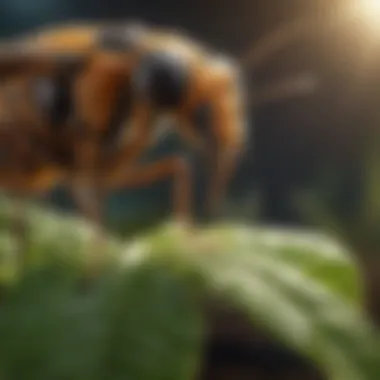Effective Strategies to Protect Plants from Insects


Intro
The subject of pests in agriculture is an important concern for farmers and plant enthusiasts alike. Insects can devastate crops, leading to reduced yields and loss of income. Therefore, understanding how to protect plants from insects is crucial for effective agricultural practices. The balance between protecting crops and maintaining ecological health is essential. This article focuses on various strategies and techniques to manage insect infestations effectively and sustainably.
Key Concepts and Terminology
Basic Definitions
To approach the topic comprehensively, it’s essential to clarify some key terms related to pest management.
- Pests: Organisms that cause harm to plants, competing for resources or directly damaging plant tissues.
- Integrated Pest Management (IPM): A holistic approach that incorporates multiple strategies to manage pest populations while minimizing harm to beneficial organisms.
- Biological Control: Utilizing natural predators or pathogens to reduce pest populations.
- Chemical Control: The use of pesticides to manage pest infestations.
Historical Context
Historically, pest management practices have evolved significantly. Early methods included manual removal and the use of crude substances to deter pests. With the advent of chemical pesticides in the mid-20th century, there was a significant shift in pest management. However, increased awareness of environmental impacts has led to a resurgence in biological and cultural practices. This shift is evident in modern practices that emphasize sustainability while maintaining healthy crop production.
Recent Innovations and Trends
Technological Advancements
New technologies have emerged in recent years to help manage insect populations more effectively. Drones are now used for surveillance to identify pest hotspots in large fields. Additionally, precision agriculture tools aid in the targeted application of pest control measures.
Sustainable Practices
Sustainability has become a focal point in agricultural practices. Techniques such as companion planting, where specific plants are grown together to repel pests, are gaining traction. Similarly, organic farming methods are emphasizing non-toxic pest control solutions and natural barriers to insects.
Practical Applications and Techniques
Step-by-step Guides
To effectively protect plants from insects, farmers can follow these guideline steps:
- Monitoring and Identification: Identify pests present in the field or garden. This could involve scouting for signs of insect damage or directly inspecting plants.
- Assessing Thresholds: Determine the level of pest infestation that necessitates control measures.
- Implementing Control Measures:
- Follow-up: After treatment, monitor the health of the plants and the pest populations to ensure effectiveness.
- For mild infestations, consider natural solutions like insecticidal soaps or neem oil.
- If larger populations are present, consider using pesticides, focusing on those that target specific pests to minimize collateral damage.
Case Studies
A practical example involves a tomato farm that faced aphid issues. By implementing biological control with ladybugs and planting garlic, the farmer reduced aphid populations significantly without chemical interventions. This case highlights the principles of sustainable pest management while maintaining crop health.
"Sustainable pest management does not only protect the crops but also the ecosystem surrounding them."
Understanding and applying these strategies effectively enable farmers and plant enthusiasts to handle insect infestations pragmatically. This article will further detail methods, emphasizing practical and sustainable approaches.
Understanding Insect Threats
Understanding the threats posed by insects is crucial for anyone involved in agriculture or horticulture. Insects can devastate plant life, leading to reduced crop yields and compromised plant health. By grasping the nature of these threats, farmers and plant enthusiasts can implement effective protective measures. This section will explore the various aspects of insect threats, establishing a framework that emphasizes identification, life cycles, and the subsequent effects of infestations.
Identifying Common Plant Insect Pests
Recognizing the signs of insect infestations is the first line of defense in protecting plants. Common pests include aphids, caterpillars, and spider mites. Each of these pests has unique characteristics. For example, aphids are small, soft-bodied insects that can cluster on stems and leaves, sucking out plant sap. Caterpillars, on the other hand, are the larval stage of moths and butterflies. They often cause more severe damage as they chew through leaves.
Identification can also involve looking for physical signs such as webbing, holes in leaves, or a general decline in plant vitality. Also, the presence of sticky residue or black sooty mold can indicate an aphid problem. Knowing which insects are prevalent helps in deploying the right strategies for their control.
The Life Cycle of Common Insect Pests
Understanding the life cycle of these pests is essential for effective management. Most insects undergo various stages: egg, larva, pupa, and adult. For instance, knowledge of the beetle's life cycle reveals that larvae can often be more damaging than adults. By knowing when these insects reproduce, farmers can target their efforts during vulnerable life stages. This timing ensures that appropriate measures such as spraying or introducing predators are used effectively.
Impact of Insect Infestations on Plant Health
The effects of insect infestations on plant health can be profound. Infested plants may experience stunted growth, leaf discoloration, and ultimately, death if the infestation is severe enough. The impact extends beyond mere aesthetics; it can influence yield and quality. Insects can also act as vectors, transmitting diseases from one plant to another, compounding the problem significantly.
When plants are under stress from pests, they may struggle to absorb nutrients and water, leading to a weakened state. This makes them more susceptible to additional stresses, including drought or disease.
"Insect infestations can transform a thriving garden into a struggling ecosystem, underscoring the necessity of understanding these threats before they escalate."
Preventive Measures


Preventive measures are essential for protecting plants from insect infestations. These strategies focus on proactive solutions that reduce the likelihood of pest problems from the start. By addressing factors such as plant selection, soil quality, and maintenance practices, one can create a robust environment that promotes healthy plant growth while minimizing insect threats. The benefits of preventive measures are manifold. They include less reliance on chemical interventions, enhanced plant resilience, and an overall improvement in crop yield.
Plant Selection and Diversity
Choosing the right plants is a crucial first step in pest management. Selecting native species or plants that are well-adapted to local conditions often leads to better resistance against pests. Additionally, incorporating a diverse range of plants can disrupt pest habitats and reduce the likelihood of outbreaks. For instance, certain plants can repel pests or attract beneficial insects that prey on harmful ones.
Here are some key considerations when selecting plants:
- Local adaptability: Select plants that thrive in local soil and climate conditions.
- Pest-resilient varieties: Look for cultivars known for their resistance to specific insect pests.
- Companion plants: Use plants that positively influence each other. Like marigolds, which can deter nematodes.
Diversity in the garden enhances ecosystem balance. It creates a less favorable environment for pests, making it more difficult for them to establish a population.
Creating a Healthy Soil Environment
Healthy soil is the cornerstone of successful plant growth. A rich, well-aerated soil will support vigorous root systems and enhance a plant's resilience against pests. Soil health can be improved by adding organic matter, such as compost or well-rotted manure, which boosts nutrient levels and promotes beneficial microorganisms.
Important aspects include:
- pH Balance: Ensure the soil pH is suitable for your plants.
- Nutrient Levels: Regularly test and amend soil for necessary nutrients like nitrogen, phosphorus, and potassium.
- Microbial Activity: Encourage microorganisms that break down organic matter and improve nutrient availability for plants.
The healthier the soil, the stronger the plants will be. Healthy plants can better withstand the stresses posed by insect pests.
Seasonal Garden Maintenance Practices
Regular maintenance practices during the growing season greatly influence plant health. This includes activities such as pruning, watering, and monitoring for signs of insect activity. Keeping an eye on your plants and their surroundings helps catch potential infestations early, allowing for prompt action.
Maintenance tasks include:
- Regular inspections: Check for early signs of insect presence. Look under leaves and on stems.
- Watering methods: Use methods that support deep root growth, like drip irrigation, to avoid creating humid conditions that pests favor.
- Pruning: Remove dead or diseased plants promptly to prevent pests from settling in.
By implementing these seasonal practices, gardeners create an environment less favorable to pests and promote overall plant vigor.
Physical Methods of Control
Physical methods of control are crucial in managing insect pests effectively while minimizing harm to the environment. These approaches leverage physical barriers, manual removal, and trapping techniques to protect plants from invasive species. They can be employed in tandem with other pest management strategies to create a holistic defense against pest infestations.
Employing physical methods is particularly beneficial because they often require no chemicals. This can help in maintaining soil health and ecological balance. Furthermore, implementing these strategies is typically simple and does not involve complex equipment or significant investments. Ultimately, they empower farmers and garden enthusiasts to take a proactive stance against insect threats.
Physical Barriers and Exclusions
Using physical barriers involves implementing structures that prevent insects from reaching your plants. This can include row covers, insect netting, and floating row covers. Such barriers trap warm air, creating a microclimate that can be beneficial for the crops.
Key benefits of physical barriers include:
- Direct protection from harmful insects.
- Reduced need for chemical interventions, leading to a more sustainable growing environment.
- Protecting young plants from pests during their vulnerable stages.
Establishing barriers is a straightforward process. Ensure that edges are securely fastened to the ground to prevent pests from slipping underneath. Regular inspections of barriers will allow for timely repairs and maintenance.
Handpicking Insects
Handpicking insects may seem labor-intensive but is an effective method for controlling minor infestations. This technique works best in smaller gardens or specific areas of larger agricultural settings. Farmers can regularly scout for pests, such as caterpillars or beetles, and remove them by hand.
This method has several advantages:
- Immediate action can directly reduce the pest population.
- No chemical residues remain on the plants, which can be particularly appealing for organic farming.
- Engaging closely with plants allows for better understanding of their conditions and needs.
While handpicking requires patience, the rewards can be significant, especially when managing delicate crops. Consider utilizing gloves or a container for effective collection.
Using Traps Effectively
Trapping is another powerful method for managing insect pests. This can involve various trap types, such as sticky traps, pheromone traps, or water traps.
To optimize trapping efforts:
- Select traps suited to specific pests. For example, pheromone traps attract specific insects by using synthetic scents familiar to the pest.
- Place traps near plant stems or entry points to maximize efficacy.
- Regularly inspect and replace traps to ensure they remain effective.
Proper trap placement and timely maintenance can significantly reduce pest populations. For example, sticky traps can effectively monitor and catch insects like whiteflies, aphids, or thrips.


"Integrating physical control methods can form the backbone of an effective pest management strategy. Through various means, they offer sustainable solutions that both protect plants and preserve ecological health."
Cultural Control Strategies
Cultural control strategies play a crucial role in protecting plants from insect invasions. These techniques focus on modifying farming practices, enhancing resilience, and creating a less favorable environment for pests. The emphasis is on prevention rather than reaction, aligning with sustainable agriculture principles. Understanding these strategies helps farmers and plant enthusiasts adopt methods that are effective in long-term pest management while maintaining the health of the ecosystem.
Crop Rotation Techniques
Crop rotation involves changing the type of crop grown in a specific area each season. This strategy disrupts the life cycles of pests and diseases, reducing their likelihood of survival and reproduction. For instance, planting legumes one year can improve soil health and shelter beneficial organisms, while subsequent years might focus on crops that deter specific pests.
Key benefits of crop rotation include:
- Disruption of pest life cycles: Changing crops means that pests can't rely on a continuous food supply.
- Improved soil health: Varied root structures and nutrient requirements help maintain the soil balance.
- Enhanced biodiversity: Encourages a diverse ecosystem that can support beneficial insects and microorganisms.
Implementing a thoughtful crop rotation plan requires assessing soil quality, climate conditions, and pest history. Understanding the specific vulnerabilities of common pests can guide which crops to rotate.
Companion Planting Benefits
Companion planting is another effective cultural control strategy that involves planting different crops in proximity for mutual benefit. Certain plants can repel pests or attract beneficial insects that prey on those pests. For example, marigolds can deter nematodes, while basil planted near tomatoes can repel aphids and whiteflies.
Advantages of companion planting include:
- Pest management: Non-toxic, natural approaches to reduce pest populations.
- Enhanced growth: Some combinations can improve growth rates and overall health of plants.
- Optimized space utilization: This method can maximize the use of available garden space efficiently.
Efficacy heavily depends on understanding which plant combinations yield the best results. Farmers should research compatible plants to create symbiotic relationships that bolster pest control efforts.
Proper Watering and Fertilization Practices
Watering and fertilization routines significantly influence plant health, making them essential elements of cultural control. Adequate watering practices ensure plants are robust, lowering stress levels that can attract pests. Overwatering can become a breeding ground for fungal diseases, which may attract pests. Likewise, using organic fertilizers can foster stronger plants resistant to pests.
Effective practices for watering and fertilization include:
- Deep watering techniques: This encourages deep root growth, increasing resilience to drought and pests.
- Balanced fertilization: Using organic fertilizers that supply not just nitrogen, phosphorus, and potassium but also micro-nutrients is vital.
- Mulching: Applying organic mulch helps retain soil moisture, improve soil structure, and suppress weed growth.
Adjusting watering schedules based on weather conditions and soil moisture can help prevent both under and overwatering. Regular soil testing can guide fertilization strategies to ensure plants get what they need without excess.
"Cultural control strategies are not merely about combating pests; they are about creating an ecosystem that thrives while managing threats to plant health and yielding sustainable productivity."
In summary, cultural control strategies are fundamental for effective plant protection against insect threats. Crop rotation, companion planting, and proper watering alongside fertilization practices are integral in maintaining healthy and productive gardens and fields. Understanding these methods empowers farmers and enthusiasts to foster a natural balance, encouraging robust plant growth while mitigating insect infestations.
Biological Control Options
Biological control options play an essential role in protecting plants from insect infestations. By leveraging natural enemies of pests, we can create a more sustainable approach to pest management. This method emphasizes the balance between controlling pests and conserving beneficial organisms. Biological control is not only effective in minimizing damage to crops, but also contributes to the overall health of the ecosystem.
Beneficial Insects as Natural Predators
Beneficial insects such as ladybugs, lacewings, and parasitic wasps are pivotal in biological control. These insects prey on or parasitize pest species, which can significantly reduce their populations without harmful side effects that chemical pesticides often bring.
For example, ladybugs consume aphids, which are notorious for damaging plants. Introducing these useful insects into the garden or farm can provide a natural way to keep pest numbers in check. When employing beneficial insects, it is important to identify the pests prevalent in your area and select the appropriate predator.
Using Nematodes and Other Microorganisms
Another avenue for biological control is the use of nematodes and microorganisms. Nematodes are microscopic worms that can be applied to soil or plants. They invade pest insects, leading to their demise. Various species of nematodes target specific pests such as grubs and root weevils, thus providing a targeted method of control.
Furthermore, certain bacteria like Bacillus thuringiensis can effectively control specific pest populations. This bacterium produces toxins that are harmful to insect larvae while posing minimal threat to non-target organisms. Many agricultural producers benefit from integrating these microorganisms into their pest management strategies.
Fostering Habitat for Beneficial Species
Creating a hospitable environment for beneficial species is crucial for effective biological control. This includes planting diverse crops and ensuring there are flowers that attract beneficial insects. Flowers such as dill, fennel, and cosmos can invite pollinators and natural predators onto the farm or garden.
In addition to plant diversity, providing shelter and nesting sites for these organisms increases their survival rates. Maintaining a balance between pest control and promoting beneficial insects helps sustain long-term health in crops.
"Successful implementation of biological control requires an understanding of the ecosystem, including the interactions among various species."
Chemical Control Solutions
Chemical control remains a critical component in the management of insect pests affecting plants. While various strategies exist—like cultural, biological, or physical approaches—chemical methods can provide immediate relief against severe infestations. The effectiveness of pesticides lies not only in their application but also in selecting the right product for specific pests while considering their impact on the environment and non-target organisms.


Understanding Pesticide Options
When choosing pesticides, it’s essential to understand the different categories available. Pesticides can be broadly categorized into insecticides, miticides, and some broader-spectrum products. Insecticides, for example, target insects specifically, while miticides are aimed at arachnids like spider mites. Each of these has its own mode of action, including systemic, contact, and residual effects, which can influence how they are absorbed and how long they remain effective.
Another crucial aspect of understanding pesticide options is our awareness of the active ingredients and formulations. Some pesticides are more selective, posing fewer risks to beneficial insects. For instance, products containing neonicotinoids have come under scrutiny for their adverse effects on pollinators, while others like Bacillus thuringiensis focus on bacterial methods to control caterpillars without harming other species. Thus, knowing the differences helps in making informed decisions.
Integrated Pest Management Approach
The Integrated Pest Management (IPM) approach integrates various strategies for managing pest populations. It emphasizes the use of chemical treatments as a LAST resort. This method begins with monitoring and identifying pest populations, understanding environmental conditions, and studying the life cycles of pests. IPM focuses on preventing pest establishment rather than simply reacting to infestations.
By combining cultural controls, biological controls, and targeted chemical applications, farmers can reduce reliance on pesticides. For example, after monitoring for aphids, a farmer might opt for a natural predator like ladybugs first. If populations remain high despite these efforts, adding a well-timed insecticide application for the target pest can be effective without causing widespread harm to beneficial organisms in the ecosystem.
Safety Considerations for Chemical Use
Safety should always be a priority when utilizing chemical solutions. This involves both the operator's safety and the health of the surrounding environment. One key recommendation is the strict adherence to label instructions regarding dosage and timing. Proper protective equipment should be worn during application, including gloves, masks, and goggles to prevent exposure.
Additionally, understanding pesticide toxicity levels is vital. Some compounds may be highly toxic to certain wildlife or beneficial insects, which could also lead to longer-term ecological damage. Implementing buffer zones when spraying near water sources or sensitive areas can further mitigate potential risks.
"Effective pest management is not solely about eradication. It's about balancing the ecosystem while protecting plant health."
Contextualizing Pest Management Practices
Understanding pest management practices in relation to the surrounding environment is vital. Insects are not uniform in their behaviors or the ecosystems they inhabit. Contextualizing pest management involves considering various elements unique to an area. Factors such as local climate, soil type, and existing flora and fauna greatly influence pest populations and their management.
Other important aspects include regional agricultural practices, pest history, and the specific crops grown. No single strategy works for every location. Adapting pest management techniques to regional specifics can increase success rates. This can lead to healthier plants and improved yields in agricultural settings.
Regional Considerations in Pest Control
Regional variations play a crucial role in how different insect pests affect plants. Factors such as temperature, humidity, and seasonal changes can alter pest behavior and lifecycle. For example, warmer climates may favor the proliferation of certain pests like aphids or spider mites. Recognizing these patterns is important for targeted management.
Farmers and gardeners should consider the following:
- Local Pest Species: Know which insects are prevalent in your area. This helps in quickly identifying potential threats.
- Seasonal Patterns: Be aware of when certain pests are most active, which can vary by region.
- Regional Practices: Understand how neighboring farms manage pests and what has proved effective or ineffective.
"Effective pest control begins with an understanding of local dynamics and environmental relationships."
These considerations enable tailored approaches, optimizing pest control efforts without unnecessary chemical use.
Sustainable Practices in Modern Agriculture
The push for sustainable agriculture alters pest management techniques. Current practices emphasize minimizing environmental impact while maintaining productivity. Integrated Pest Management (IPM) is one leading approach. This involves combining various methods, such as biological control, crop rotation, and resistant plant varieties. These methods lessen reliance on pesticides, fostering a healthier ecosystem.
Practices include:
- Promoting Biodiversity: Diverse plantings can deter pests naturally. Ensuring a mix of flora creates habitats that attract beneficial insects.
- Improving Soil Health: Healthy soil supports healthy plants, making them more resistant to pests.
- Using Organic Fertilizers: Nutrients from organic sources help reduce chemical runoff and soil degradation.
By adopting these sustainable techniques, farmers can create an ecosystem that naturally regulates pest populations.
Future Trends in Pest Management
Future pest management will likely revolve around technological advancements. Precision agriculture is becoming more commonplace. Tools such as drones, sensors, and data analytics will help farmers monitor crop health and pest populations more effectively.
Strong trends include:
- Biotechnology: Developing pest-resistant plants through genetic modification may offer new solutions.
- AI and Data Analysis: Utilizing artificial intelligence for forecasting pest outbreaks can improve decision-making.
- Sustainability Focus: Increased emphasis on eco-friendly practices will continue. Consumers are becoming more aware of chemical pesticide use, pushing markets toward organic practices.
Overall, contextualizing pest management highlights the need for regionally adapted approaches and sustainable solutions. These are essential for addressing the growing challenges that pests present in agriculture.
Finale
Recap of Essential Strategies
To summarize, the essential strategies for managing pest threats include:
- Understanding insect threats by identifying pests and their life cycles.
- Implementing preventive measures like selecting diverse plant species and maintaining healthy soil.
- Employing physical methods such as physical barriers and handpicking.
- Applying cultural control strategies through practices like crop rotation and companion planting.
- Utilizing biological control options by introducing beneficial insects and microorganisms.
- Making informed choices about chemical control solutions, including integrated pest management.
By synthesizing these approaches, practitioners can create a more resilient plant ecosystem, minimize the impact of pests, and promote healthier growth.
Encouragement for Continuous Learning
Pest management is not static; rather, it requires ongoing learning and adaptation. The field of agriculture is continually evolving, and keeping abreast of new research, techniques, and technologies is crucial. Engaging with community resources such as local agricultural extensions, online forums, and educational websites can greatly enhance one's understanding of pest management. Knowledge sharing among agricultural enthusiasts and professionals can lead to innovative solutions and best practices. This adaptable mindset not only benefits individual practices but also contributes to the larger effort of sustainable agriculture.
Staying informed will allow for informed decisions and effective pest management that honors both productivity and sustainability.















